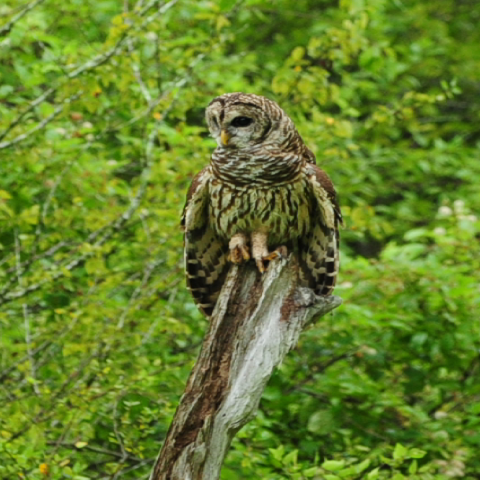The goal of this experiment was to test the feasibility of barred owl removal to determine whether it improves conditions for spotted owls. We removed barred owls from less than one twentieth of one percent of the range of the barred owl.
USFWS Wraps up Experimental Removal of Barred Owls for the Conservation of Northern Spotted Owls.
The Barred Owl Removal Experiment (Experiment) implemented Recovery Action 29 of the Northern Spotted Owl Recovery Plan - “Design and implement large-scale control experiments to assess the effects of barred owl removal on spotted owl site occupancy, reproduction, and survival.” The Service initiated work on the Experiment on the Hoopa study area in California in September, 2013, and added three additional study areas in Oregon and Washington in 2015 and 2016.
In the Final EIS, the Service stated: “The experiment will run until sufficient information is gathered to determine the effects of the removal of barred owls on spotted owl population trends.” The Service ended the removal of barred owls on the Oregon Coast Ranges, Cle Elum, and Union/Myrtle study areas in 2020. We have reached the level of information we can obtain from these study areas and have sufficient data to move forward. Removal on the Hoopa study area will be completed in August 2021.
The goal of the Experiment was to test the feasibility of barred owl removal to determine whether it improves conditions for spotted owls. The Experiment has demonstrated success in the removal of barred owls, resulting in reduced and declining barred owl populations in the removal areas. In areas where no removal occurs, barred owls continue to increase. Across all study areas, removal of barred owls had a strong, positive effect on survival of spotted owls and a weaker, but positive effect on spotted owl dispersal and recruitment. Spotted owl populations stabilized in the areas with removals, but continued to decline at a rate of 12% in the areas without removals.
Information from this Experimental will be used by the Service to develop a Barred Owl Management Strategy, along with all other available information. Keep updated on the development of this strategy here.
The most recent annual report can be downloaded here. The published study is available here.






